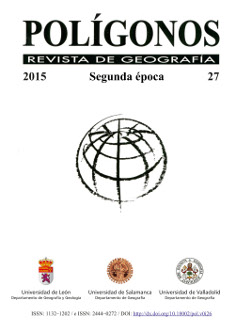Neogeografía, Big Data y TIG: problemas y nuevas posibilidades = Neogeography, Big Data and TIG: problems and possibilities
DOI:
https://doi.org/10.18002/pol.v0i27.3277Palavras-chave:
Neogeografia, GPS, SIG, Ciencia ciudadana, BIG data, GIS, Neogeography, science citizenResumo
La Neogeografía y el BIG data están cambiando la manera de investigar en Geografía, el desarrollo de estos enfoques se basa mucho en la aparición de novedades tecnológicas, en particular de nuevas tecnologías de la información geográfica: GPS, SIG, etc.
The Neogeography and the BIG data are changing the way research in geog-raphy, the development of this approach is very much based on the emergence of new technol-ogies, in particular in new technologies of geographic information: GPS, GIS, etc.
Downloads
Métricas alternativas
Referências
AGUILERA, F.; GÓMEZ DELGADO, M. y CANTERGIANI, C.C. (2010): «Instrumentos de simulación prospectiva del crecimiento urbano», Ciudad y Territorio. Estudios Territoriales, Vol. XLII (Nº165-166), 481-495.
BOSQUE SENDRA, J. (2005): «Espacio geográfico y ciencias sociales. Nuevas propuestas para el estudio del territorio», Investigaciones regionales, 2005, nº 6, 203-224. http://www.aecr.org/images/ImatgesArticles/2007/10%20Bosque.pdf
CAPEL, H. (2010): «Geografía en red a comienzos del Tercer Milenio. Por una ciencia solidaria y en colaboración». Scripta Nova. Revista Electrónica de Geografía y Ciencias Sociales. [En línea]. Barcelona: Universidad de Barcelona, 1 de febrero de 2010, vol. XIV, nº 313 [ISSN: 1138-9788 1138-9788] http://www.ub.es/geocrit/sn/sn-313.htm
CANTERGIANI, C.C. (2011): «Modelos basados en agentes aplicados a estudios urbanos: una aproximación teórica», Serie Geográfica, 17 (2011), 29 – 43. https://ebuah.uah.es/dspace/handle/10017/14343
CONNORS, JP, S. L. y MAGGI, K. (2012): «Citizen Science in the Age of Neogeography: Utilizing Volunteered Geographic Information for Environmental Monitoring», Annals of the Association of American Geographers, 102(6) 2012, 1267–1289.
ELWOOD, S.; GOODCHILD, M.F. y SUI, D.Z. (2012): «Researching Volunteered Geographic Information: Spatial Data, Geographic Research, and New Social Practice» Annals of the Association of American Geographers, 102(3) 2012, 571–590.
GOODCHILD, M.F. (2007): «Citizens as sensors: the world of volunteered geography» GeoJournal, Volume 69, Issue 4, 211-221.
GOODCHILD, M.F. (2009): «NeoGeography and the nature of geographic expertise», Journal of Location Based Services, 3: 2, 82—96. DOI: 10.1080/17489720902950374. https://www.tandfonline.com/doi/abs/10.1080/17489720902950374
GRAHAM, M. y T. SHELTON (2013): «Geography and the future of big data, big data and the future of geography» Dialogues in Human Geography, November 2013 vol. 3 no. 3, 255-261. http://dhg.sagepub.com/content/3/3/255.abstract
GRAHAM, M. y ZOOK, M. (2013): «Augmented realities and uneven geographies: exploring the geolinguistic contours of the web» Environment and Planning A 45(1) 77- 99.
GUAN, Q.; ZHANG, T. y CLARKE, K.C. (2006): «GeoComputation in the Grid Computing Age» en J. D. CARSWELL y T. TEZUKA (Eds.): W2GIS 2006, LNCS 4295, 237-246, 2006. https://link.springer.com/chapter/10.1007/11935148_22
KITCHIN, R. (2013): «Big data and human geography: Opportunities, challenges and risks» Dialogues in Human Geography, 3(3), 262-267. http://eprints.maynoothuniversity.ie/5366/1/RK_big%20data%20human.pdf
MORENO JIMÉNEZ, A. y BOSQUE SENDRA, J. (2010): «Los modelos de localización óptima como herramientas para la planificación territorial y urbana de instalaciones y equipamientos» Ciudad y territorio. Estudios territoriales, número 165-166, 461-480.
PRIETO CERDÁN, A.; CASTILLO SALCINES, V.; MIRA MARTÍNEZ, J.M.; MAS MARTIL, R.; BAÑO SÁNCHEZ, J.L. (2014): «Cooperación internacional al desarrollo: cartografía colaborativa en los sectores de Rukara y Huye (Rwanda)». XVI Congreso Nacional de Tecnologías de la Información Geográfica 25, 26 y 27 de Junio de 2014. Alicante. http://rua.ua.es/dspace/bitstream/10045/46758/1/2014_PrietoCerdan_etal_Congreso_TIG.pdf
PUMAIN, D. (2014): «Observation, observation, observation», Cybergeo: European Journal of Geography [En ligne], Editoriaux, mis en ligne le 07 mars 2014, consulté le 12 novembre 2014. https://journals.openedition.org/cybergeo/26248
SANTOS PÉREZ, J.L. (2003): «El problema de la longitud geográfica» Catastro, nº 49, 2003, 133-147. https://www.catastro.meh.es/documentos/publicaciones/ct/ct49/luisjsantos.pdf
SHELTON, T.; POORTHUIS, A.; GRAHAM, M.; ZOOK, M. (2014): «Mapping the data shadows of Hurricane Sandy: Uncovering the sociospatial dimensions of ‘big data’», Geoforum, 52, 167-179. https://doi.org/10.1016/j.geoforum.2014.01.006.
STEINIGER S. y BOCHER E., (2009): «An overview on current free and open source desktop GIS developments». International Journal of Geographical Information Science, 23(10):1345-1370
SUI, D.Z. (2008): «The wikification of GIS and its consequences: Or Angelina Jolie’s new tattoo and the future of GIS» Computers, Environment and Urban Systems 32 (2008) 1–5. http://www.sciencedirect.com/science/article/pii/S0198971507000919
TURNER, AJ (2006): Introduction to Neogeography O'Reilly Media, Inc. ISBN: 978-0-596-52995-6 Release Date: December 15, 2006. http://shop.oreilly.com/product/9780596529956.do
TURNER, AJ (2009): How-neogeography-killed-gis. https://es.slideshare.net/ajturner/how-neogeography-killed-gis
WILSON, M. y Mark GRAHAM (2013): «Neogeography and volunteered geographic information: a conversation with Michael Goodchild and Andrew Turner» Environment and Planning A 2013, volume 45, pages 10-18. doi:10.1068/a44483
Downloads
Publicado
Como Citar
Edição
Secção
Licença
Direitos de Autor (c) 2015 Joaquín Bosque Sendra

Este trabalho encontra-se publicado com a Licença Internacional Creative Commons Atribuição-NãoComercial-CompartilhaIgual 4.0.
Los autores que publican en esta revista están de acuerdo con los siguientes términos:
- Los autores ceden de forma no exclusiva los derechos de explotación (reproducción, distribución, comunicación pública, transformación) a las Universidades de León, Salamanca y Valladolid, que lo pondrán a disposición pública en la página web de la revista (http://revpubli.unileon.es/ojs/index.php/poligonos/index) y en el repositorio propio Bulería (https://buleria.unileon.es/handle/10612/374)
- Los autores pueden establecer, por separado, acuerdos adicionales para la distribución no exclusiva de la versión de la obra publicada en la revista (por ejemplo, alojarlo en un repositorio institucional o publicarlo en un libro), comunicándolo al Equipo Editorial y con un reconocimiento explícito de su publicación inicial en Polígonos. Revista de Geografía.
- Este trabajo se encuentra bajo la Creative Commons Attribution-NonCommercial-ShareAlike 4.0 International License. Puede consultarse desde aquí la versión informativa y el texto legal de la licencia.
- Los autores se compromentes a aceptar las sugerencias de los Evaluadores externos o del Equipo Editorial. En caso de discrepancia con las mismas, los autores deben justificar debidamente su propuesta.
- Se permite y se anima a los autores a difundir electrónicamente las versiones post-print (versión evaluada y aceptada para su publicación) de sus obras, ya que favorece su circulación y difusión y con ello un posible aumento en su citación y alcance entre la comunidad académica.









